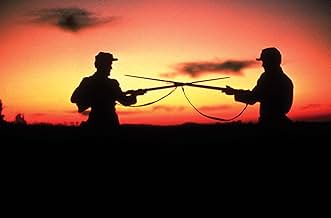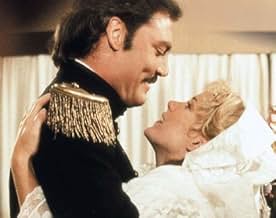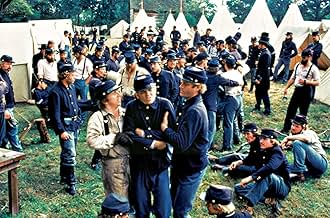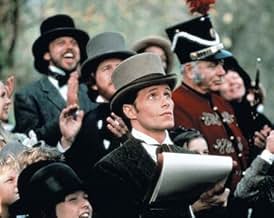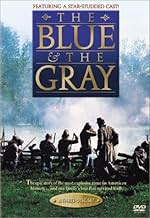America just before and during the Civil War, as seen through the eyes of an artist correspondent.America just before and during the Civil War, as seen through the eyes of an artist correspondent.America just before and during the Civil War, as seen through the eyes of an artist correspondent.
- Nominated for 4 Primetime Emmys
- 2 wins & 4 nominations total
Browse episodes
Featured reviews
I did not see this movie when it was shown as a mini-series.I happened to like this movie because it gave a simple portrayal of what it might have been like to be a family during this period and having to face the problem of a family that was divided in its loyalties . I thought the makers of this movie followed the history of the period and gave a good presentation of the issues that the people had to deal with at the time. Of course it cannot compare to the recent Civil War Movies or even the Ken Burns series . Given the time that it was made I think it was a good portrayal of the period.
My only fault with the movie was the fact that it seemed to put the fall of Vicksburg after the Gettysburg Address. I did not understand how this was allowed to happen given the fact that it seemed to be based on Bruce Catton's work. Can anyone explain this?
My only fault with the movie was the fact that it seemed to put the fall of Vicksburg after the Gettysburg Address. I did not understand how this was allowed to happen given the fact that it seemed to be based on Bruce Catton's work. Can anyone explain this?
This miniseries shows the war primarily through the eyes of a Virginian who wants to witness history but cannot commit to either side of the conflict. His new-found profession of journalism allows him to participate as a neutral observer. He is surrounded by relatives and friends on both sides, and the miniseries shows events through their eyes as well.
The human side of the war is stressed, and it excellently portrays the toll the conflict took on families.
Many of the subplots are taken from Civil War historian Bruce Catton's final work, "Reflections On The Civil War." However, none of the people in the book, including the real John Geyser, appear in the miniseries. Rather, observations made in the book are woven around the main storyline as supplementary material.
Most of the military aspects of the miniseries are laughable and bear little resemblance to reality. Due to the miniseries being done on a miniseries budget we see none of the grand scale evident in "Gettysburg" or "Glory."
Stacy Keach gives a terrific performance as Jonas Steele, the Federal special operations agent. We see from his performance a little of the decentralized, more personalized ways in which intelligence gathering and other non-standard military operations were conducted in the nineteenth century.
The miniseries ran for over six hours on CBS in 1982, but well over an hour was cut for the two-cassette video release. Get the whole treatment if you can.
The human side of the war is stressed, and it excellently portrays the toll the conflict took on families.
Many of the subplots are taken from Civil War historian Bruce Catton's final work, "Reflections On The Civil War." However, none of the people in the book, including the real John Geyser, appear in the miniseries. Rather, observations made in the book are woven around the main storyline as supplementary material.
Most of the military aspects of the miniseries are laughable and bear little resemblance to reality. Due to the miniseries being done on a miniseries budget we see none of the grand scale evident in "Gettysburg" or "Glory."
Stacy Keach gives a terrific performance as Jonas Steele, the Federal special operations agent. We see from his performance a little of the decentralized, more personalized ways in which intelligence gathering and other non-standard military operations were conducted in the nineteenth century.
The miniseries ran for over six hours on CBS in 1982, but well over an hour was cut for the two-cassette video release. Get the whole treatment if you can.
I'm not going to nitpick this film because the wrong number of buttons are on a Civil War jacket nor am I going to criticize the fact that certain battles are presented out of chronological sequence, as some others have already pointed out.
But taken as a Civil War drama, THE BLUE AND THE GRAY ranks with the very best movies made about this era of American history and all of the performances are splendid. The human drama, both on the home front before the war and during the various battles, is portrayed very realistically, as are the graphic battle scenes.
The cast assembled does a wonderful job with characters that come alive. GREGORY PECK does well as Abraham Lincoln, although his make-up is a bit disconcerting and he was a bit too mature to play the role in the first place. But STACY KEACH and JOHN HAMMOND carry much of the film as the two leading characters who witness various aspects of the Civil War, seen through their eyes and experiences, and they are excellent.
The supporting cast includes vivid performances from LLOYD BRIDGES, COLLEEN DEWHURST, RORY CALHOUN, GERALDINE PAGE, RIP TORN, STERLING HAYDEN, DIANE BAKER. BRIAN KERWIN is excellent as the Hale brother facing battle for the first time, and the sequence with the balloon to observe the enemy from the air is full of tight suspense.
It may not be a perfect history lesson, but it is photographed beautifully in color (all of it filmed in Arkansas), has a fine musical score and is well worth the time it takes to unwind a very compelling story with characters any viewer can relate to.
I consider it one of the finest made-for-TV miniseries ever made.
But taken as a Civil War drama, THE BLUE AND THE GRAY ranks with the very best movies made about this era of American history and all of the performances are splendid. The human drama, both on the home front before the war and during the various battles, is portrayed very realistically, as are the graphic battle scenes.
The cast assembled does a wonderful job with characters that come alive. GREGORY PECK does well as Abraham Lincoln, although his make-up is a bit disconcerting and he was a bit too mature to play the role in the first place. But STACY KEACH and JOHN HAMMOND carry much of the film as the two leading characters who witness various aspects of the Civil War, seen through their eyes and experiences, and they are excellent.
The supporting cast includes vivid performances from LLOYD BRIDGES, COLLEEN DEWHURST, RORY CALHOUN, GERALDINE PAGE, RIP TORN, STERLING HAYDEN, DIANE BAKER. BRIAN KERWIN is excellent as the Hale brother facing battle for the first time, and the sequence with the balloon to observe the enemy from the air is full of tight suspense.
It may not be a perfect history lesson, but it is photographed beautifully in color (all of it filmed in Arkansas), has a fine musical score and is well worth the time it takes to unwind a very compelling story with characters any viewer can relate to.
I consider it one of the finest made-for-TV miniseries ever made.
Back in the early Sixties there was a short lived television series called The Americans about two brothers who after their father was killed decided to fight on opposite sides in the Civil War. The whole business about brother against brother was no exaggeration. Right up to the very top with Mary Todd Lincoln having relatives who fought for the Confederacy, families were torn apart. The Blue And The Gray brings that aspect of the Civil War better than any other film made for the big or small screen since The Americans.
The families are the Geysers and the Hales related by the mothers, Diane Baker and Colleen Dewhurst being sisters. The Hales are from Gettysburg, Pennsylvania and the Geysers from what would now be West Virginia in and around Harper's Ferry and that's not even 100 miles distance. But the families are true to the sectional divide.
With the exception of John Geyser played by John Hammond who has made a black friend, a free man played by Paul Winfield who gets lynched for helping runaway slaves. He won't fight for a section that espouses slavery as a cause, but won't enlist in the Northern Armies either. A passing acquaintance played by Stacy Keach who gets himself involved in a lot of the major events of the war and married into the Hale family with Julia Duffy persuades Hammond to become a war correspondent and put his artistic talents to good use. Hammond becomes a pictorial chronicler of the seminal event of his generation.
Without ever losing control of the main story lines, what happens to the various Geyser and Hale family members, The Blue And The Gray captures the sweep and pageantry of the Civil War. Such real characters as Abraham Lincoln played by Gregory Peck and John Brown played by Sterling Hayden in what was his farewell performance do take a life of their own. With Peck we see a public and a private Lincoln which is true to the Lincoln mythology and yet quite a human character.
If I had to single out one performance that was especially touching it would be that of David W. Harper as one of the Hale brothers. The young man was eager to be the first to enlist in his town of Gettysburg, but he never made it to the battle that town became famous for. A not well covered portion of the war was the lack of sanitary facilities in army camps. Young Harper falls victim to dysentery and his performance will move you.
A few years later North and South covered a lot of the same ground that this particular mini-series did and it was as well done as The Blue And The Gray. I would recommend them both highly especially for young audiences to gain a real understanding of what the Civil War meant to the average individual/
The families are the Geysers and the Hales related by the mothers, Diane Baker and Colleen Dewhurst being sisters. The Hales are from Gettysburg, Pennsylvania and the Geysers from what would now be West Virginia in and around Harper's Ferry and that's not even 100 miles distance. But the families are true to the sectional divide.
With the exception of John Geyser played by John Hammond who has made a black friend, a free man played by Paul Winfield who gets lynched for helping runaway slaves. He won't fight for a section that espouses slavery as a cause, but won't enlist in the Northern Armies either. A passing acquaintance played by Stacy Keach who gets himself involved in a lot of the major events of the war and married into the Hale family with Julia Duffy persuades Hammond to become a war correspondent and put his artistic talents to good use. Hammond becomes a pictorial chronicler of the seminal event of his generation.
Without ever losing control of the main story lines, what happens to the various Geyser and Hale family members, The Blue And The Gray captures the sweep and pageantry of the Civil War. Such real characters as Abraham Lincoln played by Gregory Peck and John Brown played by Sterling Hayden in what was his farewell performance do take a life of their own. With Peck we see a public and a private Lincoln which is true to the Lincoln mythology and yet quite a human character.
If I had to single out one performance that was especially touching it would be that of David W. Harper as one of the Hale brothers. The young man was eager to be the first to enlist in his town of Gettysburg, but he never made it to the battle that town became famous for. A not well covered portion of the war was the lack of sanitary facilities in army camps. Young Harper falls victim to dysentery and his performance will move you.
A few years later North and South covered a lot of the same ground that this particular mini-series did and it was as well done as The Blue And The Gray. I would recommend them both highly especially for young audiences to gain a real understanding of what the Civil War meant to the average individual/
This was a very good film about the Civil War. It showed the mindset of people living in the south during that era; how they were swayed into entering a futile and dangerous undertaking. The agony of war was shown at its worst, depicting the loss of the combatants as well as bystanders. Any war is horrible, but the war between the states is more so because of its utter uselessness. The waste of life and material should never have been allowed to happen. I recommend this movie; the action sequences are dramatic and well done, however, I felt some of the scenes seemed a bit underpopulated.
Did you know
- TriviaSome filming took place at Prairie Grove Battlefield State Park in Arkansas. The film crew built a false side onto a historic building there, then blew it off for a special effect, assuring the State park officials that no harm would come to the building. The explosion was larger than promised, damaging the historic house's structure.
- GoofsWhen John Brown is hanged for the uprising at Harper's Ferry, the apple trees are in full blossom. John Brown was hanged on 2 December 1859.
- Quotes
Abraham Lincoln: It's well known that the more a man speaks, the less he's understood.
- ConnectionsReferenced in Saturday Night Live: Drew Barrymore/Squeeze (1982)
- SoundtracksRock of Ages
Lyrics by Augustus Montague Toplady (as Augustus M. Toplady)
Music by Thomas Hastings
- How many seasons does The Blue and the Gray have?Powered by Alexa
Details
Contribute to this page
Suggest an edit or add missing content




